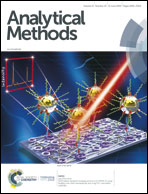A novel cyclometallated iridium(iii) complex based dual-mode phosphorescent probe for detection of acidity and bovine serum albumin†
Abstract
A novel phosphorescent, water-soluble cyclometallated iridium complex [(fppy)2Ir(BQCOOH)] (fppy = 4-(2-pyridyl) benzaldehyde, BQCOOH = 2,2′-biquinoline-4,4-dicarboxylic acid) (Ir-C) was synthesized and characterized. Analysis found that Ir-C exhibited strong orange-red phosphorescence, which peaked at 630 nm under alkaline conditions and remained stable (pH > 7.0). Its response signal decreased with the increasing acidity of the aqueous system. Ir-C worked as a quencher of the luminescence of nitrogen-doped carbon quantum dots (N-CQDs) with an electron transfer mechanism, and the prepared N-CQDs were introduced into the aqueous system of Ir-C to prepare a visual ratiometric pH probe. Due to the error of single emission probes in different environments, a visual ratiometric probe is more advantageous for accurate and simple detection of the acidity of water. At pH 2.5, the quenched luminescence signal can be restored with subsequent addition of bovine serum albumin (BSA) due to the several interactions between Ir-C and BSA, mainly electrostatic interactions, hydrophobic interactions, and deprotonation and protonation of the ligand. Based on this observed phenomenon, a “turn on” kind of luminescent sensor was constructed for quantification of BSA. Under optimal conditions, a wide linear detection range of 20–140 nM was obtained with a limit of detection (LOD) of 7 nM.



 Please wait while we load your content...
Please wait while we load your content...